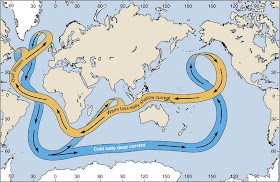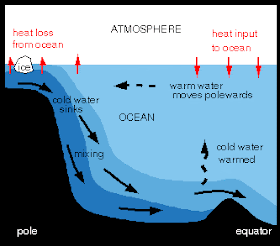· Oceans influence atmospheric processes by albedo, moisture circulation and energy transfer.
- Atmospheric processes influence oceanic processes, for example waves receive their energy from the winds as they blow across the surface of water. The size of waves depends upon the velocity, fetch (how far it travels) and duration of wind.
- Energy is redistributed through oceans by thermohaline circulation. This helps to maintain the global climate.
 |
| Themohaline Circulation |
Thermohaline Circulation
The thermohaline circulation, otherwise known as the ‘ocean gyre’ or ‘global ocean conveyor belt’, is large-scale oceanic circulation that is controlled by changes in water density (which in turn affects its buoyancy) caused by variations in temperature and salinity. Thermohaline circulation has a symbiotic relationship with global climate. We have already examined how heat is transferred around the Earth by the atmosphere now we must also consider the role of the oceans in the distribution of heat.
Salinity: the saltier, the denser.
Ocean circulation is largely controlled by temperature gradients. Water cools and sinks at the poles and travels towards the equator along the seabed. At the equator these currents rise, warm and overturn (upwelling) to flow back towards the polar oceans.
Seawater is 2-3 % denser than freshwater, therefore, pure freshwater floats.
- Evaporation: removes pure fresh water.
- Freezing of sea ice: removes pure fresh water.
- Formation of glaciers: reduces runoff.
- Precipitation: adds pure fresh water.
- Runoff from land (including from melting glaciers): adds pure fresh water.
- Melting of sea ice: adds pure fresh water.
 |
| How slanity and temperature affect the density of water. |
Processes that decrease salinity:
Why is the sea salty?
Salt in the sea or oceans originates from land. Chemical (solution) weathering of rocks and soils on land by aeolian, fluvial and anthropogenic frees up salt compounds that are then transported to the oceans via rivers.
Other important facts:
· The ocean works for a state of equilibrium – any dissolved salt added to the ocean is removed into oceanic sediment.
· Temperature variations with depth: at the tropics and temperate regions a thermocline exists, where temperature reduces rapidly with depth. However, in the polar oceans the water is constantly cold from the surface to the seabed.
The thriller ‘The Day After Tomorrow’ tells the sensationalised story of dramatically abrupt climate change brought about by the shutdown of the North Atlantic oceanic conveyor as a result of rapid melting of the ice caps disrupting the natural balance of fresh and saline water.
For further investigation into the theory of abrupt climate change I recommend the article 'Abrupt climate change and the thermohaline circulation: Mechanisms and predictability' by Jochem Marotzke. It can be accessed from the Proceedings of the National Academy of Sciences of the USA website:



No comments:
Post a Comment